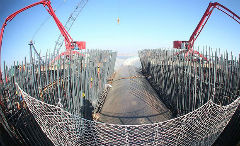Cleaner, greener Yangtze on the agenda
2017-12-29
China Daily
China will close all petrochemical enterprises and sewage outlets in environmentally sensitive areas along the Yangtze River by the end of June next year, the National Development and Reform Commission said on Dec 28.
“These areas include nature reserves and drinking water sources,” said Luo Guosan, head of the Department of Basic Industries under the NDRC, the country’s top economic regulator.
The country will also close all illegal petrochemical enterprises with excessive pollutant emissions within a 1-kilometer radius of the Yangtze River by the end of next June, said Luo.
“Legally operating enterprises within the 1-kilometer radius will be encouraged to relocate,” Luo said, adding that all petrochemical enterprises within 1 kilometer of the riverbank will either be closed or relocated by 2020.
By the end of 2016, around 11,000 petrochemical enterprises were operating along the Yangtze River. There are more than 8,000 sewage outlets with an annual discharge capacity of 100,000 cubic meters along the country’s longest river, according to the NDRC.
“Shutting down these petrochemical enterprises will result in long-term benefits, since environmental benefits are more important than economic gains,” said Wu Xiaohua, deputy head of the Academy of Macroeconomic Research under the NDRC.
It is common for petrochemical enterprises to locate along big rivers, due to convenient transportation and easy access to water in case of emergencies, said Wu.
In recent years, they have been shifting from the lower reaches of the Yangtze River to the less-developed upper and middle reaches to reduce operating costs, Wu said.
China will focus on pollution prevention and control over the next three years, according to the statement released after last week’s Central Economic Work Conference.
The country has made environmental protection and restoration a top priority of its development plan for the Yangtze River Economic Belt, a national strategy to boost concerted development in riverside regions and provide new growth drivers for the country’s economy.
“In the first three quarters of this year, 77.3 percent of the region’s water met the Grade III standard or above, up by 2.5 percentage points from last year,” Luo said.
The country also closed all 959 illegal docks along the Yangtze River by the end of September, 809 of which have undergone ecological restoration, he said.
In the first three quarters of this year, the combined GDP of the nine provinces and two municipalities involved in the Yangtze River Economic Belt amounted to 26.7 trillion yuan ($4.1 trillion), up more than 8 percent year-on-year, according to the NDRC.


